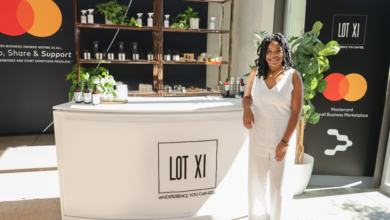‘It has not gotten better’

Thirty years ago, after three relentless days of rioting in South Central Los Angeles following the acquittals of the four police officers caught on video beating Black motorist Rodney King with their nightsticks following a car chase, a shaken King issued an impassioned plea.
“Please, I just want to say, you know, can we all get along?” he asked, his voice quivering.
By then, King, who suffered multiple injuries including a fractured skull, broken bones and damage to his internal organs from the beating, had become a nationwide symbol of police brutality. The acquittals of the officers, three of whom were white, ignited a vitriolic response from some Black Angelenos in South Central that also targeted another ethnic group: Korean Americans, many of whom had their neighborhood stores looted or burned to the ground.
If the trial verdict proved an agonizing event for the Black community, the riots that began on April 29, 1992, were equally so for Korean Americans. To this day they use the word Sa-I-gu, which translates in Korean to 4/29, the date the violence erupted — a shorthand similar to 9/11, symbolizing unspeakable trauma.
If there is a single collective memory among the Korean Americans who lived through the riots, it may be of those in the community who took it upon themselves to guard stores against looters while the LAPD seemed to cede control of the neighborhood to the rioters. Some were armed with handguns and rifles and climbed on rooftops to scan the area for potential trouble, a surreal image that was played on television screens across the country and seemed to signal the beginning of a race war. By the time the police did move in to reestablish order, the neighborhood lay in ruins. Sixty-five percent of the businesses that had been ransacked, looted and destroyed were owned by Koreans, who incurred 40% of the roughly $1 billion in property damage tallied in the rioting.
The racial strife between the Korean and Black communities that was laid bare in the riots was not an isolated event. The uneasy relationship rapidly deteriorated after the killing of Latasha Harlins, a 15-year-old girl who was shot in the back of the head by Korean convenience store owner Soon Ja Du in 1991 over an allegation of shoplifting. Du accused Harlins of trying to steal a $1.79 bottle of orange juice. Police later determined otherwise, noting that Harlins had $2 in her hand at the time she was killed.
Du’s son testified at the trial that prior to the shooting, shoplifting incidents at the store occurred approximately 40 times per week, gang members had threatened his life and people had often threatened to burn the business down. A jury found Du, then 51, guilty of manslaughter. The judge in the case, who reasoned that Du acted out of fear due to previous robberies at the store, sentenced her to five years probation and no jail time.
Harlins’s death and the light sentence handed down to the store owner enraged the Black community. “It still hurts,” Latasha’s cousin Shinese Harlins-Kilgore told NBC News in 2021.
While three decades have passed since King made his impassioned plea, the communities affected by the L.A. riots are still figuring out how to get along. The tension between Korean store owners and Black customers is far from resolved, and an atmosphere of distrust continues to hover like a cloud. How much distrust compared with that expressed during the riots? One community leader believes it’s worse than most people understand.
“I’d say 80%. I would give it an eight out of 10. It has not gotten better,” the Rev. Mark Whitlock, senior pastor at Reid Temple AME Church, told Yahoo News.
Before becoming a full-time pastor of a predominantly Black congregation in Maryland, Whitlock served as executive director of Fame Renaissance, an economic arm of First AME Church in Los Angeles, which raised more than $400 million in grants and loans that created over 4,000 jobs in South L.A. before Rodney King became a household name.
The Rev. Najuma Smith-Pollard, a Southern California native and assistant director at USC Center for Religion & Civic Culture, was also a member of First AME Church in Los Angeles when the 1992 riots unfolded. On April 8 of this year, she spoke at an interfaith prayer breakfast held at Wilshire United Methodist Church in Los Angeles, recalling the conflicting emotions of driving through the unrest three decades ago. “I was between faith and fear, in a very dynamic way,” Smith-Pollard said, adding, “I wasn’t afraid of my people. I was afraid of what the future might look like if we don’t fix this.”
Part of a monthlong campaign to revisit the ugly chapter in L.A.’s history and to promote unity, the prayer breakfast was held just a few miles from the notorious South L.A. intersection of Florence and Normandie, the site where the violence exploded. A stumbling block to that goal, however, is that the Black community in places like South Central has yet to see tangible economic gains, Whitlock said.
“I think people are concerned about our economy,” he said. “They’re concerned about world wars. They’re concerned about gas prices. More than that, they’re concerned for their safety. Unless we begin to deal with that in a transparent way, [the unrest] which took place in 1992 could very easily take place [again].”
Overall, Black people in the U.S. have made economic and health gains, but they’ve slipped further behind whites in terms of education and social justice. According to this year’s Equality Index, released by the National Urban League, the median household income for Black people ($43,862) is 37% less than that of whites ($69,823).
For Asian Americans, the trajectory isn’t wholly upward, either. A 2018 Pew Research Center analysis indicated that income inequality in the U.S. was greatest among Asians, displacing Blacks as the most economically divided ethnic group. The gap in the standard of living between Asians near the top and those at the bottom of the income ladder nearly doubled between 1970 and 2016, and the distribution of income among Asians went from being one of the most equal to being the most unequal. While Asians overall rank as the highest-earning racial and ethnic group in the U.S., it is not a status shared by all Asians.
To be sure, though the L.A. riots exposed simmering racial tensions, the 2020 coronavirus pandemic once again brought them to the forefront.
Thousands of Asian Americans nationwide reported verbal and physical attacks over the last two years. There were 10,905 reported hate incidents against Asian Americans and Pacific Islanders from March 2020 to December 2021, according to Stop AAPI Hate. The majority of the incidents involved verbal harassment (63%), and almost half (48.7%) took place in public spaces. More hate incidents were reported in 2021 (6,273) than in 2020 (4,632).
Violent crimes soared in Los Angeles and other major cities in the past year. According to the LAPD, citywide robberies are up 44% in 2022 compared with last year and 57% compared with 2020. What was most concerning was the increase in the levels of violence and the frequent use of a firearm connected to those crimes, said LAPD Chief Michel Moore.
In January, a violent encounter at a liquor store in Long Beach, about 20 miles south of L.A., awakened more painful memories. A 65-year-old Asian store owner, Yongja Lee, was stabbed in the neck by a Black man, according to Long Beach police, paralyzing her from the neck down and robbing her of the ability to speak.
Incidents like these have kept some in the Korean community on edge and the memory of the Rodney King riots fresh.
An MBA student at the University of Southern California at the time of the riots, Hyepin Im, told Yahoo News that she remembered thinking to herself, “Why aren’t other communities feeling the same pain?”
“I saw our community kicked down and crying a lot,” Im said.
Now the president and founder of the nonprofit Faith and Community Empowerment, a national group serving the Asian American community, Im has made it her mission to heal the divide. In 2012 she launched a campaign called Serve, Advocate, Inspire, Give and Unite (SAIGU), to commemorate the anniversary of the L.A. riots.
This month the campaign is sponsoring a series of events seeking to help the Korean community reassess the lessons from 1992 and use them as a catalyst to combat myths and create an open dialogue with other minority groups.
“I think it’s unfortunate that, being humans, many times we tell myths about one another,” Im said. “When we can have … honest conversations that open eyes and open hearts, then I think that’s where true solidarity can happen.”
Im disputes the claims made by some in the Black and Latino communities that Asian store owners receive special treatment on government loans when purchasing a business and that Korean Americans are guilty of a predatory attitude when they open stores in neighborhoods like South Central.
Many Asian store owners are earning less than $3,000 per month, she pointed out, a sum that’s divided among their employees. As a result, many store owners say they turn to family labor rather than hiring from the greater community because they are simply unable to afford to do otherwise.
A 2022 report published by UCLA showed that thousands of low-income Asian American households in California also struggle to obtain funding to keep their businesses afloat. The report found that only 11% of Asian Americans who applied for government aid received it. The rate of rent relief for Asian Americans was half of what the data showed for white households (21%) and Black households (20%).
“There are many platforms where our communities do get along, but I think in the area of store owners and customers, that’s one where I think there’s a narrative that these store owners are exploiting, profiteering, stealing the community’s wealth,” Im said.
Im co-moderated the unity prayer breakfast at Wilshire United Methodist Church that brought together advocates and community leaders, including Whitlock, who collaborated with Im on an opinion piece published online in 2021 in which he explained how the Black community should support the idea that “Asian lives matter.”
Once he learned about the challenges facing the Korean community, it opened his eyes, Whitlock said, and made him realize that the biggest hurdle in bringing the two communities together was increasing an awareness of what the other had been through.
“We are one spoke in the wheel of life,” Whitlock said. “It’s time for us to see the rest of the spokes, because if we don’t, we will never roll together. And if we don’t roll together, we will perish together.”
























































